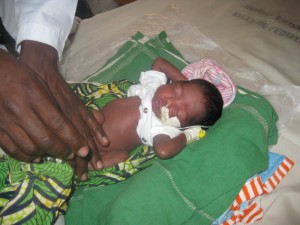While mortality among children under age 5 has improved greatly, the gains have largely been among children at the older end of that grouping. When it comes to mortality in the first week of life, little has changed.
“Early neonatal mortality rates haven’t decreased in the last two decades,” says Grace Chan, MD, PhD, a pediatrician at Boston Children’s Hospital, who conducts global health research at Harvard School of Public Health. “In developing countries, they still hover near 30 deaths per 1,000 live births.”
Early-onset infections—ones that arise within a week of birth—account for a significant portion of those deaths. Such infections may arise when a newborn picks up bacteria present in the mother’s birth canal during delivery, or from maternal infections during pregnancy.
In developed countries, interventions like prophylactic antibiotics and quick diagnoses help to keep neonatal infection rates low. But these kinds of interventions are less available in developing nations, where they could have the most impact. And while risk factors for neonatal infections have been well studied in developed nations, they are less well known in resource-poor environments, where the infections most frequently occur.
To put it another way, when it comes neonatal sepsis in developing countries, there’s a lot we don’t know.
To get a better grasp of what we do, Chan and collaborators at the Bloomberg School of Public Health at Johns Hopkins University conducted a meta-analysis of 83 studies published over a 53-year period examining infection risk factors for newborns in both developing and developed countries.
Some of the team’s results, reported in PLoS Medicine, confirm what was already suspected about infectious links between mother and newborn. For instance, across the studies examined, risk factors for maternal infection (such as a mother’s water breaking early) increased a newborn’s infection risk over the first week of life 2.3-fold. If a mother had a laboratory-confirmed bacterial infection at the time of delivery, her baby’s risk went up 6.6-fold.
Surprisingly, bacterial colonization—where the mother is a bacterial carrier but isn’t actually infected—was a more significant risk than a lab-confirmed infection. In Chan’s meta-analysis, it increased a baby’s risk of infection 9.4-fold.
Most striking, though, was the knowledge gap the analysis revealed.
Of the studies that met the team’s inclusion criteria, the majority looked at risk factors in resource-rich environments. Only seven studies were conducted in what the team called “high neonatal mortality settings,” where newborns are twice as likely to die from infectious diseases.
We have little data on the risks of neonatal infections in low-income settings or populations, where the burden of disease is highest.
“We have little data on the risks of neonatal infections in low-income settings or populations,” says Chan. “However, the burden of disease is highest in areas like sub-Saharan Africa and southeast Asia that fit these economic descriptions.”
In addition, the studies were skewed heavily toward babies infected with group B streptococcus (GBS), which is common in the developed world but less frequent in developing nations. Meaning that it’s not clear which species predominantly cause newborn sepsis in the developing world.
“GBS colonization has increased recently in developed countries,” Chan notes. “You rarely saw it in the 1980s, but now the colonization rate among pregnant women is about 35 percent.
“But it’s not as prevalent among pregnant women in developing countries,” she points out. “In Bangladesh, for instance, the rate is about 7 percent.”
That focus on GBS in the literature also may help in part explain why in the team’s analysis a baby’s sepsis risk was higher if her mother was colonized, but not infected, at delivery.
“The majority of studies looking at maternal colonization focused on GBS, and we know there are particularly virulent strains of GBS associated with early-onset neonatal sepsis,” Chan explains.
All told, Chan’s results indicate the need for more research in areas with the highest burden of early neonatal infection. But, as she argues, there are some steps that health authorities can take now, like broader use of prophylactic antibiotics (especially in regions where mortality risk from early-onset sepsis is high) and development and adoption of better methods for diagnosing and treating infections in mothers during labor.
“We need better diagnostics to look for infections in the mothers and newborns, something that’s faster and more sensitive than the gold-standard bacterial culture,” Chan says. “We also need a better understanding of the maternal microbiome. What are the good bacteria, and what are the bad? And where is the best place to intervene on the continuum between mother and child so as to reduce the risk of infection? These are all things we hope to learn.”







